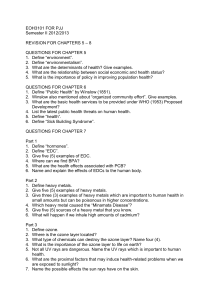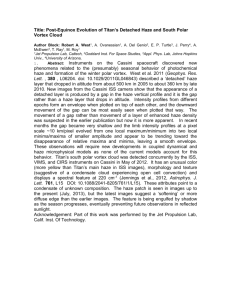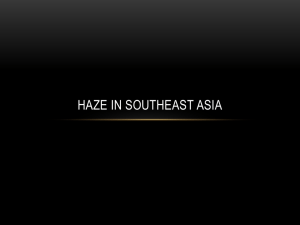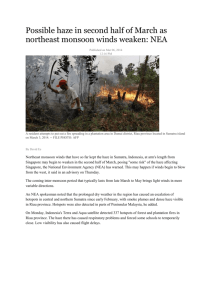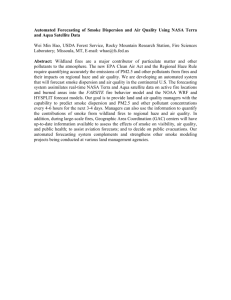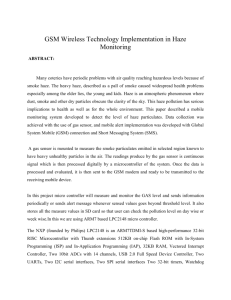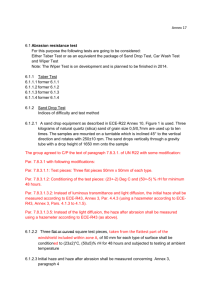Highlights
advertisement
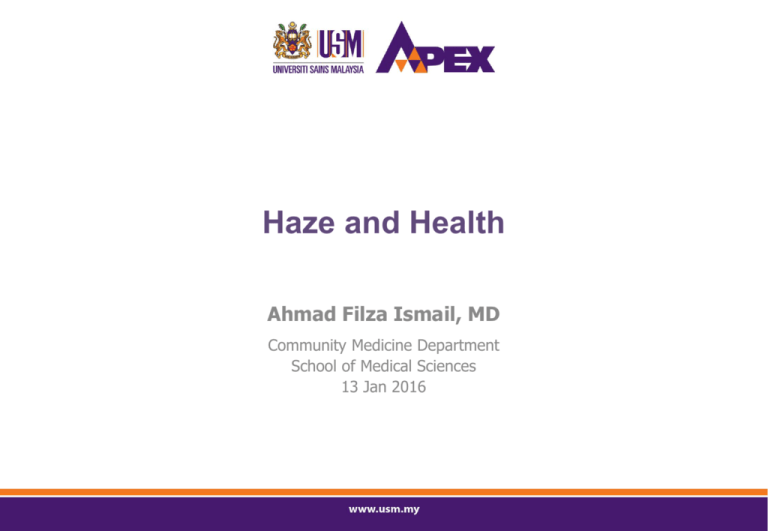
Haze and Health Ahmad Filza Ismail, MD Community Medicine Department School of Medical Sciences 13 Jan 2016 Outline Introduction Haze and outdoor air quality Impact haze on health Factors influence the impact (Disaster) Management Cycle – – – – Prevention Preparedness Response Recovery • Researches www.greatermalaysia.com • • • • • 2 Introduction • What is fog? Vapor condensed to fine particles of water suspended in the lower atmosphere • What is smoke? The gaseous products of burning materials especially of organic origin made visible by the presence of small particles of carbon • What is smog? A photochemical haze caused by the action of solar ultraviolet radiation on atmosphere polluted with hydrocarbons and oxides of nitrogen – Smoke + Fog • What is haze? Atmospheric moisture, dust, smoke, and vapor that diminishes visibility 3 www.thefreedictionary.com • Haze is traditionally an atmospheric phenomenon where dust, smoke and other dry particles obscure the clarity of the sky • The haze events were classified as biomass burning, complicated and secondary pollutions • Main constituents of haze: 1. The high concentrations of PM10 due to the intrusion of particles arising from forest fire 2. The high concentrations of NO3− and SO42− acidic rain 3. The high concentration of Fe due to land clearing activities and exposed soil Norela, S., Saidah, M.S. and Mahmud, M., (2013). Chemical composition of the haze in Malaysia 2005. Atmospheric Environment, 77, 1005-1010. Du, H., Kong, L., Cheng, T., Chen, J., Du, J., Li, L., Xia, X., Leng, C. and Huang, G., (2011). Insights into summertime haze pollution events over Shanghai based on online water-soluble ionic composition of aerosols. Atmospheric Environment, 45(29), 5131-5137 4 Haze and Outdoor Air Quality Air Quality Index or Air Pollutant Index API system includes 5 major air pollutants which could cause potential harm to human health should they reach unhealthy levels. The air pollutants included in Malaysia's API: 1. Ozone (O3), 2. Carbon monoxide (CO) 3. Nitrogen dioxide (NO2) 4. Sulphur dioxide (SO2) 5. Particulate matter with a diameter of less than 10 micron (PM10). 5 DOE, 1997 6 DOE, 1997 7 DOE, 1997 8 DOE, 1997 What is health? http://www.csum.edu/ • Health is a state of complete physical, mental and social well-being and not merely the absence of disease or infirmity www.who.int/about/definition/en/print.html World Health Organization 9 Impact of Haze on Health Short term effects • Respiratory symptoms • Irritation of the eyes, nose, and throat • Irritation of the skin Long term effects • Contributed to a higher risk of: http://asthma.bsd.uchicago.edu/ – Shortness of breath, wheezing – cardiovascular effects – reduced lung development – the development of chronic respiratory diseases, such as asthma, in children MOH, 2007 Psychological effects? 10 https://www.studyblue.com/notes/note/n/phlt-150-study-guide-2013-14-barcellos/deck/11182105 11 Factors Influence the Impact • Host – – – – – – – Age (too old and too young) Pre-existing health problem / co-morbid condition Immunocompromised individual Occupation / Activities involved Knowledge, attitude and practice Route of transmission Smoking / Vaping http://www.aqhi.gov.hk/en/health-advice/health-effects-of-air-pollutants6193.html 12 • Environment – – – – – – Location Time of exposure / Type of exposure Temperature Humidity Home design Pressure 13 • Agent / Substance – The chemicals / particles involved • • • • • • Ozone (O3), Carbon monoxide (CO) Nitrogen dioxide (NO2) Sulphur dioxide (SO2) Particulate matter with a diameter of less than 10 micron (PM10) Others – Concentration – Chemical and physical properties – Toxic level 14 Prevention • The measures taken to eliminate the root causes that make people vulnerable to disaster • Prevention planning is based on two issues: 1.hazard identification (identifying the actual threats facing a community) 2.vulnerability assessment (evaluating the risk and capacity of a community to handle the consequences of the disaster) http://www.cartercenter.org/resources/ 15 Mitigation • Referred to reduction of the risk of a disaster • Primary mitigation refers to reducing the resistance of the hazard and reducing vulnerability • Secondary mitigation refers to reducing the effects of the hazard (preparedness). • Mitigation includes recognizing that disasters will occur; attempts are made to reduce the harmful effects of a disaster, and to limit their impact on human suffering and economic assets • In haze? http://www.cartercenter.org/resources/ 16 Hierarchy in Prevention and Control http://www.e-hazard.com/blog/hierarchy-of-controls-approach-to-workplace-hazards/ 17 Preparedness • Disaster preparedness refers to measures taken to prepare for and reduce the effects of disasters. That is, to predict and, where possible, prevent disasters, mitigate their impact on vulnerable populations, and respond to and effectively cope with their consequences • Example: The children, the elderly, those with existing lung and heart diseases, advice, stock of face mask, evacuation plan http://www.ifrc.org/en/ 18 Response • The primary aims of disaster response are rescue from immediate danger and stabilization of the physical and emotional condition of survivors • Example: face mask distribution, evacuation, treatment of patients http://www.ifrc.org/en/ 19 Recovery • Recovery refers to those programmes which go beyond the provision of immediate relief to assist those who have suffered the full impact of a disaster to rebuild their homes, lives and services and to strengthen their capacity to cope with future disasters • Example: lung rehabilitation, redesign the home, educate the public http://www.ifrc.org/en/ 20 Researches • Abas, M.R.B., Rahman, N.A., Omar, N.Y.M., Maah, M.J., Samah, A.A., Oros, D.R., Otto, A. and Simoneit, B.R., (2004). Organic composition of aerosol particulate matter during a haze episode in Kuala Lumpur, Malaysia. Atmospheric Environment, 38(25), 42234241 • Highlights – Samples were collected by high-volume air filtration during the haze episode of 1997 around the University of Malaya campus near Petaling Jaya – These results show that the samples contain n-alkanes, n-alkan-2-ones, nalkanols, methyl n-alkanoates, n-alkyl nitriles, n-alkanals, n-alkanoic acids, levoglucosan, PAHs, and UCM as the dominant components, with minor amounts of terpenoids, glyceryl esters and sterols, all derived from natural biogenic sources (vascular plant wax), from burning of biomass, and from anthropogenic utilization of fossil fuel products (lubricating oil, vehicle emissions, etc.). – The results interpreted in terms of major sources are due to local build-up of organic contaminants from vehicular emissions, smoke from biomass burning, and natural background as a result of the atmospheric stability during the haze episodes 21 • Omar, N.Y.M., Mon, T.C., Rahman, N.A. and Abas, M.R.B., (2006). Distributions and health risks of polycyclic aromatic hydrocarbons (PAHs) in atmospheric aerosols of Kuala Lumpur, Malaysia. Science of the total environment, 369(1), 76-81 • Highlights – Ambient and street level distributions of PAHs were similar and their occurrence was attributed to vehicular emissions. – However, in haze particles, a different pattern of PAHs was observed, characterized by relatively low levels of benzo[a]pyrene (BaP) and high levels of benzofluoranthenes (BFs). – The BaP equivalency results showed that the potential health risk associated with haze smoke particles was 4 times higher than that of street level particles whereas the lowest health risk was associated with ambient atmospheric particles. 22 • Awang, M.B., Jaafar, A.B., Abdullah, A.M., Ismail, M.B., Hassan, M.N., Abdullah, R., Johan, S. and Noor, H., (2000). Air quality in Malaysia: impacts, management issues and future challenges. Respirology, 5(2), 183-196 • Highlights: – Observations on major air pollutants in Malaysia including nitrogen dioxide, carbon monoxide, the ozone and total suspended particulate matter (particularly PM10), and sulfur dioxide, emitted from industrial and urban areas from early 1970s until late 1998. – Total suspended particulate matter was the main pollutant – Since 1980, six major haze episodes were officially reported in Malaysia: April 1983, August 1990, June 1991, October 1991, August to October 1994, and July to October 1997. – Studies have shown that should no effective countermeasures be introduced, the emissions of sulfur dioxide, nitrogen oxides, particulate matter, hydrocarbons and carbon monoxide in the year 2005 would increase by 1.4, 2.12, 1.47 and 2.27 times, respectively, from the 1992 levels 23 • Sahani, M., Zainon, N.A., Mahiyuddin, W.R.W., Latif, M.T., Hod, R., Khan, M.F., Tahir, N.M. and Chan, C.C., (2014). A casecrossover analysis of forest fire haze events and mortality in Malaysia. Atmospheric Environment, 96, 257-265 • Highlights: – We modelled association of haze events and daily mortality using a casecrossover study design. – Days with daily PM10 > 100 μg/m3 were defined as haze events. – Haze events were significantly associated with natural and respiratory mortality at various lags. – Immediate effects of haze were particularly seen among males. – Children and adult females mortalities were associated with delayed effects. 24 • Forsyth, T., (2014). Public concerns about transboundary haze: a comparison of Indonesia, Singapore, and Malaysia. Global Environmental Change, 25, 76-86 • Highlights – The paper analyzes public concerns about haze in Indonesia, Singapore and Malaysia – It compares crises in 1997, 2005, and 2013, using newspaper content analysis – Public debate is increasingly critical of Indonesia and palm oil companies – The Association of South East Asian Nations (ASEAN) treaty on haze is criticized – Public criticism is becoming more overt despite media controls 25 • Othman, J., Sahani, M., Mahmud, M. and Ahmad, M.K.S., (2014). Transboundary smoke haze pollution in Malaysia: inpatient health impacts and economic valuation. Environmental Pollution, 189, 194-201 • Highlights – Transboundary smoke haze is an annual phenomenon in Malaysia. – No evidence of seasonal factors in smoke haze related inpatient cases. – Inpatient rates during a haze event increased by 31% relative to normal days. – Annual economic loss due to inpatient health impact of haze valued at $91,000. – Present value of economic loss estimated at $1.1 million to $1.7 million. 26 • Aditama, T.Y., 2000. Impact of haze from forest fire to respiratory health: Indonesian experience. Respirology, 5(2), 169-174 • Highlights: – There was a significant impact of haze to the human lung. – There was a significant increase in respiratory conditions, lung function complaints and other related impacts. 27 • Emmanuel, S.C., (2000). Impact to lung health of haze from forest fires: the Singapore experience. Respirology. 5(2). 175182 • Highlights: - There was a 30% increase in outpatient attendance for haze-related conditions. - An increase in PM10 levels from 50 μg/m3 to 150 μg/m3 was significantly associated with increases of 12% of upper respiratory tract illness, 19% asthma and 26% rhinitis. - Supplementary findings from scanning the electron microscopic sizing of the haze particles showed that 94% of the particles in the haze were below 2.5 μm in diameter. This was consistent with emissions from combustion sources originating over 500 km from Singapore. - During the same period, there was also an increase in accident and emergency attendance for haze-related conditions. - There was no significant increase in hospital admissions or in mortality. 28 Summary • The main concern is haze from anthropogenic activities • The main pollutant is PM10 • The health impact is due to the several factors • To minimize the impact, proper management is important • The phenomenon is expected to reoccur and the air quality is worsening 29 30 31 • Prof Dr Baharudin Abdullah ENT Surgeon, Otorhinolaryngologist • Assoc Prof Dr Nor Azwany Yaacob Public Health Physician, Epidemiologist and Biostatistician • Dr Mohd Zarawi Mohd Nor Counselor, Medical Education • Dr Nik Rosmawati Nik Husain Public Health Physician, Environmental Health • Dr Fahisham Taib Paediatrician • Dr Ahmad Filza Ismail Public Health Physician, Environmental Health 32 Thank You 33 Transforming Higher Education For A Sustainable Tomorrow
